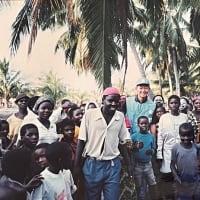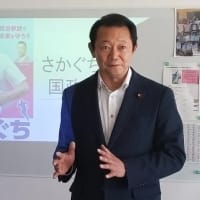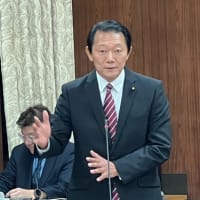今日はハンガリーのブダペストで国連ボランティア計画が主催するGlobal Volunteer Conference 2011で基調講演をする予定でした。残念ながら国会日程が二転三転し、今日、衆議院本会議が開かれることになったので、招待を辞退。昨夜ビデオメッセージを作成し、私自身のスピーチに代えて、ビデオメッセージと原稿で参加することになりました。実際には会期延長手続きをしただけだったので本会議は30秒ほどで終了。拍子抜けでしたが、私の他にもうひとり日本から参加しスピーチをされた日本赤十字社の方が、今から数時間前に流された私のビデオメッセージの感想と写真を送って下さいました。本当にありがたく感激しました。
*ブダペストの会場に流れた私のビデオメッセージ

会議のテーマはボランティアが紛争の解決や災害からの復興に果たすべき役割、また「現場」で活動する視点で、様々な危機を未然に防ぐため、どのように取り組み、成果を挙げてきたのかを議論することでした。私自身のスピーチの内容は、ボランティアとしての経験、特に国連カンボジア暫定統治機構において、選挙を実施する地域の責任者として山岳少数民族の村で生活・活動した経験をもとに、現地の人々の声を聞き、その心を自分の心とする努力が信頼醸成につながること、また、東日本大震災の後、被災者の方々の生の声を聞くため、身分を明かすことなく、一緒に汗を流すことで得た問題意識を政府につなぐことを目的として、民主党内に「震災ボランティア室」を立ち上げ活動していることなどを紹介した上で、ボランティアこそが、政策決定者と、弱い立場の方々をつなぐ重要な役割を果たし得ることを強調しました。
原文は英語なのですが、そのまま掲載します。
Keynote Address
By Naoto Sakaguchi
Member of the House of Representatives, Japan
In Occasion of Global Volunteer Conference,
Budapest, Hungary
16th September 2011
Greetings to the organizers, panelists and participants of the Global Volunteer Conference 2011. My name is Naoto Sakaguchi. I am a member of the House of Representatives in Japan. Thank you very much for inviting me for this very important conference to define the future of volunteerism. Please accept my apologies for not being able to be there with you. However, as a life-time volunteer, it is my great pleasure that I am able to be a part of celebrating the 10th anniversary of International Year of Volunteer in 2011. Also taking this opportunity, I would like to express my heartfelt thanks to everybody who has offered support to the people affected by the massive earthquake and tsunami that struck eastern Japan and the accident of the Fukushima Daiichi nuclear power plant.
1. My activities as a UN volunteer, and trust building that only volunteers can achieve
My thought regarding volunteerism is based on my own experiences with UNV. It was June 1992, that I applied to join UNV and Mr. Kevin Gilroy interviewed me. Kevin recruited a candidate who speaks terrible English and it became a turning point of my life. Anyway, I started to serve as a UNV Electoral Supervisor under UN Transitional Authority in Cambodia (UNTAC) responsible for coordinating the electoral process with local people who had no experience of elections, since they had no democracy through their long civil war.
In UNTAC, I lived and worked for about a year in ethnic minority villages in Rattanak-Kiri province. Villagers were living deep in the rain forest without running water, electricity or even toilets. What they did have, however, was many landmines and unexploded shells. I lived in one villager’s bamboo house, and started my activities. It was very difficult to gain cooperation from the villagers who had suffered numerous invasions. My activities did not go well in a first place.
One day, I rescued a boy who had been injured in an animal trap, and carried him on my back to our village 20 kilometers away. The boy and his family didn’t express any appreciation directly to me. However, the atmosphere of the people in the village dramatically changed from the very next day. I learnt that the ethnic minority’s language doesn’t have a word to mean ‘Thank you’, since it’s taken for granted that people support each other in such hard living conditions. But the family visited all houses in my village to express their appreciation to me. People’s attitude toward UNTAC then became very cooperative, and our voter education activities went very smoothly after that. This is the experience that has brought me to the insights that I want to share with you today.
The region I was responsible for produced outstanding results in the election in May, with an almost 100 % voting rate. I believe that trust building with villagers was a key to achieve this result, and I believe that this experience shows that volunteering is one of the most valuable means of building trust.
Unfortunately, our success came with a painful cost. In April 1993 just one month before the election, Atsuhito Nakata, who had been my room-mate during the 2 month orientation in Phnom Penh, was shot and killed during his service.
I would like to let you know what happened after his death. People congregated at the place where he was killed, and a village was formed there. Atsuhito was known as Atsu, and the meaning of Atsu in Khmer is “a person who has overcome difficulty.” The village came to be called Atsu village.
Atsu’s father, Mr. Takehito Nakata decided to follow Atsu’s footstep and dedicated his life to promotion of global volunteerism. He established the Atsuhito Nakata Memorial Foundation, and was designated as one and only UNV Honorary Ambassador. He is the person who originally proposed marking International Year of Volunteer in 2001. His activity was supported by people from all over the world and, Atsu village had a school, a hospital and opportunities for self help. Atsu’s physical life was lost, but his spirit for peace is still alive and giving hope to the most vulnerable people.
I think that these experiences show something extremely important. They show that respect for others, especially respecting the small voices of the most vulnerable members of society, must lie at the very base of all that we do. We really have to try hard not to miss hearing voices especially from women, children, and minorities. Mutual respect must be on the basis of democracy in order to ensure that democracy reaches its full potential. It must also be the basis of trust building for conflict resolution and conflict prevention. And volunteers, sharing their lives with people, are in a better position that anyone can access the real voice of the people and build mutual respect and trust.
2. Volunteerism in Japan after the Great East Japan Earthquake
In response to the Great East Japan Earthquake and subsequent tsunami disaster on March 11th, most of the people in Japan and international community have expressed their volunteerism in many ways such as donation, provision of emergency items and disaster volunteering on the ground. Despite the remoteness of the disaster affected areas, some seven hundred thousand people in total have joined disaster volunteering so far, which is really impressive and inspiring. Comparing with the case of the great Hanshin Awaji Earthquake in 1995, while the total number of volunteers mobilized in Hanshin earthquake still exceeded over the case of March 11th disaster, the total number of volunteer mobilized during 4 and 5 months after the March 11th disaster exceeded over the case of Hanshin earthquake. Hundreds of wonderful individual volunteer stories have been introduced by media every day and some of them were introduced globally.
Apart from the total number of volunteers and individual volunteer stories, what has not yet been fully introduced to the people in the world are the government’s recognition of disaster volunteering, the volunteer coordination and management mechanism which has been developed after the Hanshin earthquake in 1995 and multi-sector collaboration.
First, in response to the disaster, Japanese government expressed the recognition of disaster volunteering and counted on the power of disaster volunteers. Prime Minister immediately appointed the special advisor on disaster volunteering and established the volunteer coordination office in the Cabinet secretariat. Also, I took an initiative to establish the Office for Volunteers in Response to the Earthquake within the Democratic Party of Japan with the members who thought volunteering is the best way to understand the actual situation by which the best recovery policy measure can be formulated. First, we collected the information necessary for emergency aid. This was followed by the provision of emergency aid, and then by activities to clear off mud and rubble. Now we actively deal with a variety of activities in order to help people recover their lives. At the same time, the Office for Volunteers has provided the members of the Diet and secretaries with an opportunity to volunteer at the disaster affected area without showing their positions.
Second, the coordination mechanism for volunteering which has been developed after the Hanshin earthquake in 1995 was put into practice in response to the March 11th disaster. Due to the total of some 1 million volunteers mobilized to respond to the Hanshin earthquake, the year of 1995 was regarded as a turning point in the emergence of volunteerism as a major form of civic engagement. On the other hand, Japan has learnt the importance of volunteer management for the effective emergency and recovery assistance.
In this regard, volunteerism has been well integrated into Disaster Measures Basic Law and Basic Disaster Prevention Plan, which spell out a framework for disaster-related volunteer activities. Based on this, government and local public authorities have collaborated with volunteer involving organizations and developed the capacity of disaster volunteering management through the experiences in response to the numerous natural disasters every year. This highly developed mechanism of disaster volunteer management was put into practice immediately after March 11th disaster. 80 disaster volunteer centers were immediately established by the local Council of Social Welfares supported by the Japan National Council of Social Welfare. Through those disaster volunteer centers, the needs were identified and matched with the total number of 700,000 volunteers.
Third, the damage caused by the earthquake and tsunami and wide-range of needs of assistance for emergency relief and recovery were actually beyond capacity of the planned operations of the disaster volunteer centers. To address this, variety of collaboration with different organizations, sectors and means have been witnessed. Several organizations including local authorities outside of disaster affected areas, labor union, international NGOs, Japan Red Cross society provided the disaster volunteer centers with human resources to support their expanded operations. Over 700 CSOs including domestic volunteer involving organizations and international NGO amazingly worked together to form a wide-ranged coordination network called “Japan Civil Network for Disaster Relief in East Japan (JCN).” JCN has organized the regular meeting with the Volunteer Coordination Office of the Cabinet secretariat and other related ministries and agencies. JCN also has promoted public-private collaboration.
Finally I would like to highlight some of the newly emerging disaster volunteers. Corporate volunteers have made the great contributions to the emergency and recovery assistance. A large number of corporations have deployed corporate volunteers in organized and sustainable manner, which helped the disaster volunteer centers tremendously in bridging the coordination gap derived from the unpredictable and unstable participation pattern of individual volunteers. They utilized their dormant volunteer holiday systems for the first time. Private corporations including travel agencies, academic institute and local authority provided the disaster volunteers with so called “volunteer bus” taking them to the disaster volunteer centers in an organized manner. New communication tools such as website and social media tremendously facilitated the information sharing and actual coordination between volunteers and assignments.
I would also like to mention the great success of multi-sector volunteer centers and CSR activities by lots of private corporations. Collaborating with different sectors, volunteer activities have moved forward. Japanese volunteer activities have played an important role in the response to this earthquake and have given hope and courage to those who were affected by this massive disaster.
3. Conclusion
Through our volunteer activities in Tohoku, we heard the voices of the most vulnerable people and gained much insight. Based on my disaster volunteer experience, I am now envisioning a future eco-city creation in Tohoku. The plan is to re-build the Tohoku region as a sustainable society with recyclable energy and new employment. Through the experience of the disasters including the accident of Fukushima power plant, I think a paradigm shift has been occurred in relationship between the people and society. Since the disaster, we Japanese have often used the word “Kizuna” which means a bond of friendship or a tie that binds people together. Volunteerism is in the heart of the new sustainable society which I envision.
Volunteer activities strengthen the trust and solidarity between volunteers and the people in the disaster area. Volunteering also inspires the people toward the recovery from the disaster and the reconstruction of the society. Volunteers can work with people in need closely, and contribute their own skill and knowledge in their own way. At the same time volunteers can learn and grow as persons who can contribute to the peace and development of the world. Focusing on people is what is most important for achieving a sustainable future.
If we stay only in the Diet building, or work only at UN HQ, we never reach the reality of the world that the most affected people are facing. To create a better future, we need to uphold social equity and justice. I believe, volunteers, specifically volunteers working in the field, can be the bridge to connect policy-makers to the reality of the world.
Today, I introduced how the mechanism to facilitate effective disaster volunteering has been developed in Japan and how it worked in responding to the March 11th disaster and what were the challenges and how Japan addressed and overcame them so that the volunteerism of the half millions of people have effectively delivered to the people in need. The knowledge and experience of Japan in this regard should be shared globally especially with the participants of the Global Volunteer Conference in order to achieve the priority of action spelled out in the Hyogo Framework of Action towards achieving sustainable and resilient society globally.
In this regard, as a policy maker who strongly believes the value of volunteerism in all level, I would like to strongly support the achievement of sustainable society of which volunteerism is in a heart and the initiative to support to develop an enabling environment to explore the full potential of volunteerism for the sustainable society.
Thank you very much.




















先生の体力には感心します。自転車の後ろ走ってる秘書さんの方が必死な感じで笑ってしまいました(笑)